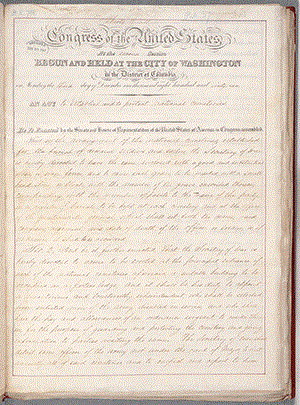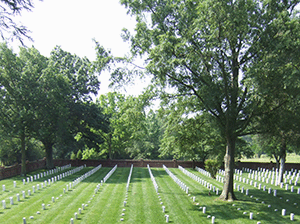Facts: NCA History and Development (1 of 3)
1. History and Development of the National Cemetery Administration
The National Cemetery Administration (NCA) is one of three federal agencies responsible for managing national cemeteries. It also provides headstones, markers, and medallions, and Presidential Memorial Certificates for qualified Veterans. While not officially designated as NCA until 1998, its administrative birthday is 1973 when Congress passed the National Cemeteries Act. This legislation created an agency within the Veterans Administration (VA) to oversee the national cemetery system, which dates to the American Civil War (1861–1865). After passage, the U.S. Army transferred 82 national cemeteries and 31 other burial sites to VA, while retaining ownership of Arlington and Soldiers' Home national cemeteries. In addition to NCA and Army, the National Park Service (NPS) oversees 14 national cemeteries, most affiliated with Civil War battlefields. Another federal agency, the American Battle Monuments Commission (ABMC), oversees 26 American military cemeteries — associated with World War I and II — located outside of the United States.
The history of all national cemeteries begins with the Civil War and President Abraham Lincoln. The first national cemeteries were developed at the start of the Civil War (1861–1865) to bury Union dead. The Civil War was the result of passionate and opposing philosophies surrounding slavery and the nation's future. An unprecedented number of men enlisted for federal service and by the early 1870s, more than 350,000 Union dead had been buried in a national cemetery. While originally intended for those who died during the war, Civil War Veterans argued for the right to be buried next to their compatriots. Since then, criteria for burial in national cemeteries have expanded dramatically in the areas of family eligibility and military service.
The U.S. Army Office of the Quartermaster (AOQM) was responsible for provisioning U.S. troops in life and in death. In September 1861, General Orders No. 75 assigned responsibility for fallen troops to the AOQM, which marked graves with a wood headboard and maintained burial records. Mounting death tolls led Congress on July 17, 1862, to empower President Abraham Lincoln "to purchase cemetery grounds and cause them to be securely enclosed, to be used as a national cemetery for the soldiers who shall die in the service of the country."

An act to establish and protect National Cemeteries.
More men died of disease or their wounds than in battle, so the first national cemeteries were established near military hospitals, prison camps, and recruitment and training centers. After the war, the National Cemetery Act of February 22, 1867, was the first legislation to substantively finance and develop national cemeteries. The law appropriated $750,000 to purchase land and to construct superintendents' lodges, perimeter walls and fencing, and acquire headstones. It also provided funds to pay "superintendents" — usually disabled Civil War Veterans hired to oversee the cemeteries.
Immediately after the Confederate surrender on April 9, 1865, the AOQM embarked on an ambitious four-year program to recover the remains of Union troops. The Cemeterial Branch, established 1867, scoured campaign routes, battlefields, former hospitals and prisons, and shorelines in search of temporary graves. Unless friends or family claimed the body for burial elsewhere, remains were relocated to national cemeteries. When the reburial program concluded in 1871, the Army estimated that 300,000 Veterans were reinterred in 73 national cemeteries or in soldiers' lots located within private cemeteries. This was the first time a country gathered its dead for reburial in cemeteries created to honor their service. Around 42 percent of Civil War dead could not be identified, making them the largest segment of unknown burials in NCA cemeteries. (To learn more about these efforts, see Edmund Whitman's 1869 Report on Reburying Union Dead in National Cemeteries).
Concurrent to establishing the national cemetery system, in 1865 the federal government established facilities to care for disabled, indigent Civil War veterans. The nine original National Homes for Disabled Volunteer Soldiers (NHDVS) campuses included dormitories, hospitals, kitchens, churches, and recreational facilities in a park-like setting. Veterans who died there were buried in Home cemeteries; these eventually become national cemeteries.
In addition, far afield from Civil War fighting, cemeteries established in western and southwest territories incorporated older post burials and include the remains of many soldiers killed in conflicts with Native Americans, known as the Indian Wars (1867–1891).
 Fort Harrison National Cemetery.
Fort Harrison National Cemetery.As the Army abandoned unneeded posts along settler trails, remains from post cemeteries were moved to national ones. In many cemeteries, by policy or practice, the Army initially identified burial sections to segregate officers from enlisted men, White from Black soldiers, and knowns from unknowns.
The 1870s marked a significant period of improvement for military cemeteries as permanent masonry structures replaced temporary frame construction. Failing wood headboards were replaced with the first durable marble headstones after the Secretary of War approved the design in 1873; unknown graves were marked with small numbered marble blocks. Notably, "Civil War" is not inscribed on headstones and the iconic recessed shield was not part of the original design. The shield, containing raised letters, was introduced by one of the successful bidders, and by 1888 the design was included in government-headstone specifications. In 1879, Congress authorized the provision of government headstones for Veterans buried in private and municipal cemeteries.
The cemetery lodge — a residence and office for the superintendent — was the most prominent building at early cemeteries. More than 50 fashionable French Second Empire-style lodges were erected, and about half survive today. Other standard nineteenth-century features included a flagpole, enclosure walls with metal gates, and rostrums as the locus of Decoration (later Memorial) Day activities. Abundant trees and ornamental plantings, pedestrian and vehicular paths, decorative "gun monuments," and signs created a solemn but verdant setting for visitors. Beyond the neat, formal arrangement of standard marble headstones that set national cemeteries apart from other burial grounds, they emulated popular American cemetery trends: the garden-like Rural (1831–1870s) and pastoral Lawn Park (1855–1920s) styles. The grounds also reflect the vision of landscape architect Frederick Law Olmsted who, in 1870, recommended national cemeteries be simple with "permanent dignity and tranquility…a sacred grove."
Members of the U.S. military have died in service abroad from the earliest days of the republic. The general practice from the late eighteenth through mid-nineteenth centuries was to bury those who died abroad in a plot near their place of death or at sea. For instance, many soldiers killed in the Mexican-American War (1846–1847) were buried in a group grave in Mexico City. This practice changed beginning with the Spanish-American War and other conflicts in the Philippines and the Far East (1898–1902). War dead from these events were repatriated for burial in private plots or national cemeteries. On June 11,1899, burial policy was further extended to Veterans of those conflicts. Government-issued headstones used the same Civil War design but with the conflict name inscribed below the shield.

















